Pachelbel’s Canon in D, a beloved Baroque composition, is renowned for its soothing melody and harmonic richness․ Its popularity endures, especially in weddings and educational contexts․ The sheet music, available as a free PDF download, allows musicians to perform this timeless piece with precision and grace․
Today, it remains a staple in classical repertoire, cherished by both professionals and students․
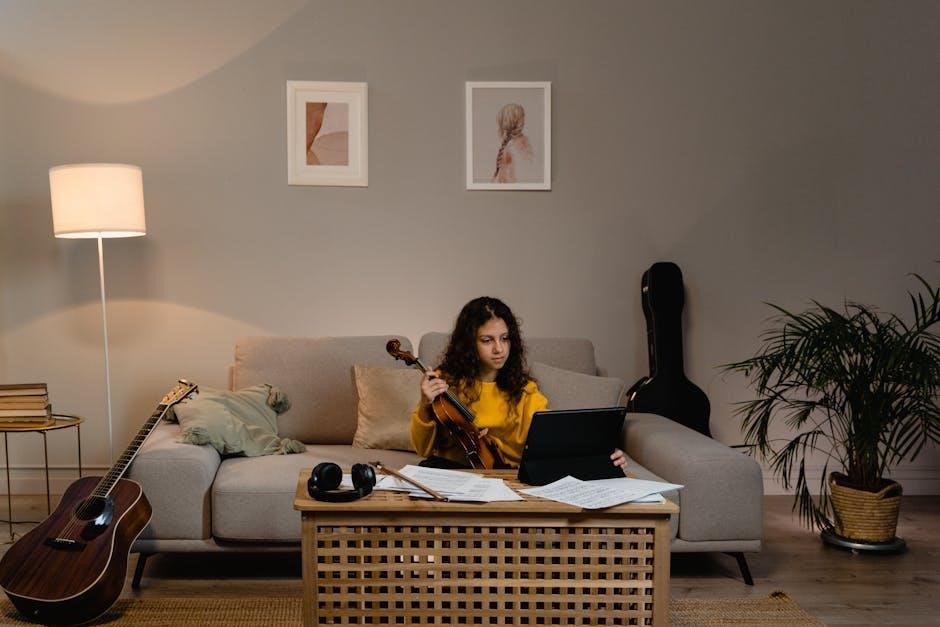
Composer Background
Johann Pachelbel, a prominent Baroque composer, created music that was widely admired during his lifetime․ His works spanned sacred and secular genres, reflecting his diverse musical expertise․
Early Life and Training
Johann Pachelbel was born in 1653 in Nuremberg, Germany, to a musical family․ His father, Ambrosius, a musician, likely nurtured his early interest․ Pachelbel studied music theory and organ playing, developing foundational skills․ He attended the University of Altdorf, where he refined his compositional abilities․ His training under prominent musicians, including Johann Christoph Bach, shaped his expertise․ This education laid the groundwork for his future compositions, including the iconic Canon in D, which remains a cornerstone of Baroque music and a popular choice for violin sheet music arrangements․
Musical Influence and Style
Pachelbel’s music was deeply rooted in the Baroque era, characterized by its structured form and rich harmonies․ His compositions, particularly the Canon in D, showcase a masterful use of counterpoint and repetitive bass lines․ This style, known as the “chordal riff,” became a hallmark of his work․ Influenced by contemporary composers like Johann Christoph Bach, Pachelbel’s music bridges sacred and secular genres․ His ability to blend simplicity with complexity ensured his works’ enduring appeal, making the Canon in D a favorite for violin sheet music arrangements and performances across various settings․
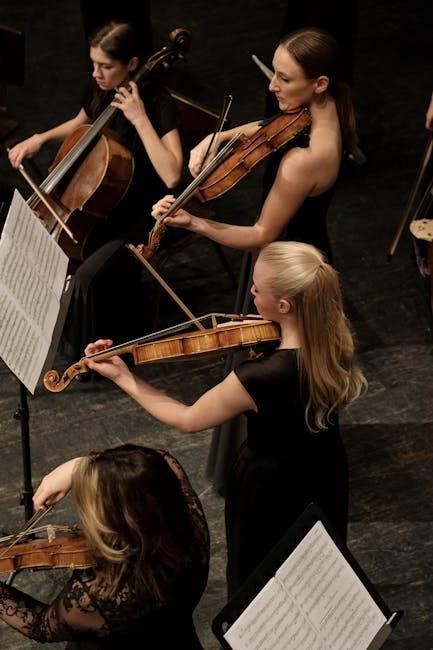
Composition Details
Pachelbel’s Canon in D, a Baroque masterpiece, features a basso continuo and three violins․ Its structured harmony is widely used in sheet music PDFs for performances and education․
Structure of the Canon
Pachelbel’s Canon in D is structured as a canon, where a melody is repeated at intervals by different instruments․ The composition is built on a bass line, with three violins playing variations above it․ Each violin part enters with a delay, creating a layered effect․ The canon is followed by a gigue, adding rhythmic contrast․ The piece is known for its harmonic simplicity and balance, making it accessible for performers․ The structure is clearly detailed in the PDF sheet music, aiding musicians in understanding and executing the piece accurately․
Harmonic Elements
Pachelbel’s Canon in D features a renowned ground bass in D major, repeated throughout the piece․ The harmonic structure is built on a chord progression that includes tonic, dominant, and subdominant chords․ The interplay of suspensions and resolutions creates a sense of tension and relaxation, enhancing the piece’s emotional depth․ Secondary dominants are used to add variety while maintaining harmonic stability․ The PDF sheet music clearly outlines these harmonic elements, making it easier for musicians to interpret and perform the piece faithfully, ensuring the timeless beauty of the Canon is preserved in every rendition․
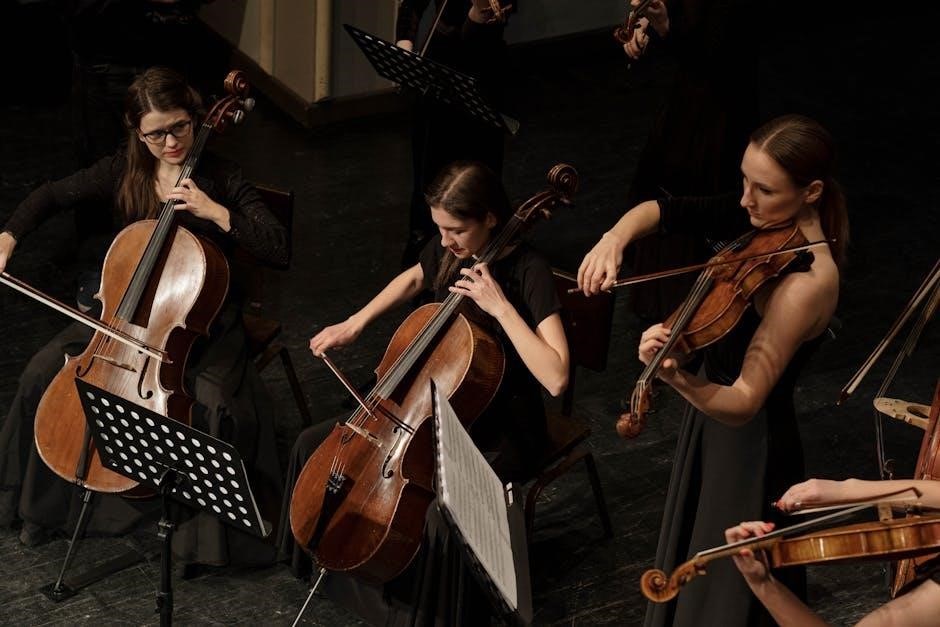
Historical Context
Pachelbel’s Canon in D, composed in the late 17th century, was initially overlooked after his death in 1706․ Rediscovered in the 20th century, it became a beloved classic․
Original Manuscript
The original manuscript of Pachelbel’s Canon in D was composed in the late 17th century but was lost for many years․ Rediscovered in the 20th century, it provided valuable insights into the composer’s intent․ The manuscript, now preserved in the Dresden State Library, reveals intricate details about the piece’s structure and harmonic complexity․ Its rediscovery has been instrumental in creating accurate sheet music versions, ensuring the piece’s authenticity for modern performers․ The manuscript remains a vital historical artifact, connecting today’s musicians to Pachelbel’s original vision․
Revival in Popularity
Pachelbel’s Canon in D experienced a remarkable resurgence in popularity during the 20th century after being largely forgotten․ Its elegant, repetitive harmonic structure made it a favorite for weddings, commercials, and films․ The widespread availability of sheet music, particularly in PDF format, allowed musicians worldwide to perform and adapt the piece easily․ This revival not only introduced the Canon to new audiences but also solidified its place in modern culture․ Its timeless appeal continues to inspire both classical and contemporary interpretations, ensuring its enduring relevance in music history․

Sheet Music Overview
Pachelbel’s Canon in D is widely available as a free PDF download, offering high-quality sheet music for violins and other instruments․ The PDF format ensures easy access and printing, making it a popular choice for musicians worldwide․
Features of the PDF
The PDF version of Pachelbel’s Canon in D offers clear, high-quality sheet music ideal for musicians․ It includes precise notation, dynamic markings, and instrumental separations․ The file is easily downloadable and printable, ensuring crisp readability․ Many versions feature layered parts for violins, violas, and bass, making it versatile for ensembles․ Some PDFs also include MIDI files for digital playback and practice․ The format is compatible with music notation software, allowing for edits or transpositions․ Its accessibility and detailed layout make it a preferred choice for both professional performances and educational purposes, ensuring accurate interpretation of Pachelbel’s timeless composition․
Versions Available
Pachelbel’s Canon in D is offered in multiple arrangements to suit various needs․ The original composition for strings is widely popular, but adaptations for piano, guitar, and other instruments are also available․ Orchestral versions provide a grand, layered sound, while chamber music versions offer intimacy․ Some PDFs include all parts together, while others separate by instrument, such as Violin I, II, and III․ Both free and paid versions exist, with paid options often including additional features like MIDI files or transpose capabilities․ These diverse arrangements ensure accessibility for musicians of all skill levels and ensemble types, making the piece universally adaptable and enduringly popular․
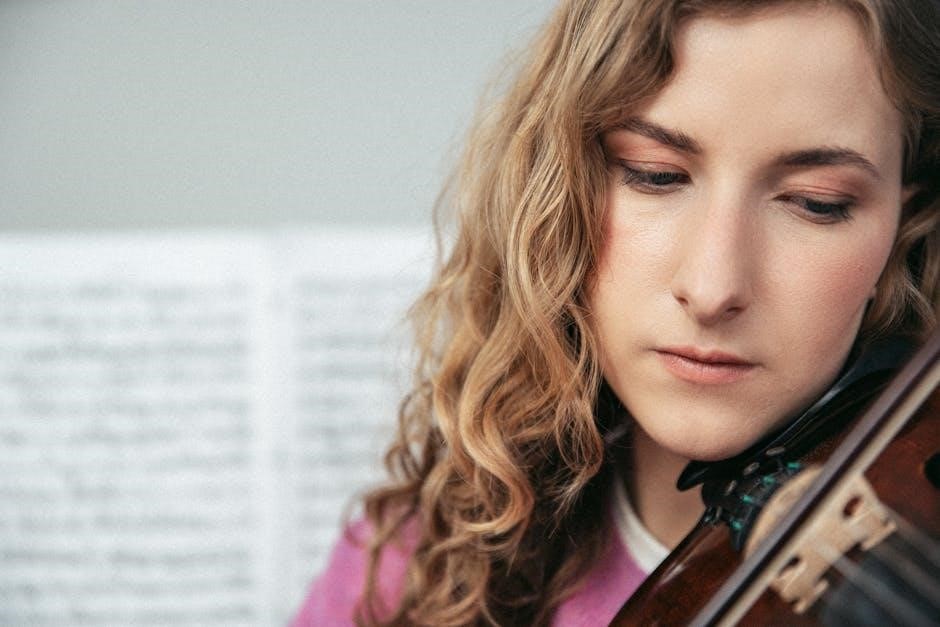
Violin Sheet Music
The violin sheet music for Pachelbel’s Canon in D is widely available, offering precise notation for each part․ Both solo and ensemble versions exist, ensuring accessibility for all skill levels․
Violin I Part
The Violin I part in Pachelbel’s Canon in D features the iconic, flowing melody that defines the piece․ It is typically played in a higher register, providing a lyrical contrast to the accompanying voices․ The sheet music for Violin I includes intricate details such as dynamics and articulation, guiding musicians to achieve the desired Baroque phrasing․ Available in PDF format, it is easily accessible for download and practice, making it a valuable resource for both students and professionals aiming to master this beloved composition․
Violin II and III Parts
The Violin II and III parts in Pachelbel’s Canon in D provide harmonic and rhythmic support, often mirroring the structure of the Canon․ These parts typically follow a pattern of descending arpeggios, creating a rich, layered sound․ The sheet music for these parts is widely available in PDF format, offering clear notation for dynamics and articulation․ While they may seem simpler than the Violin I part, they are essential for maintaining the piece’s iconic texture․ Musicians are encouraged to focus on precise timing and subtle phrasing to enhance the overall performance․
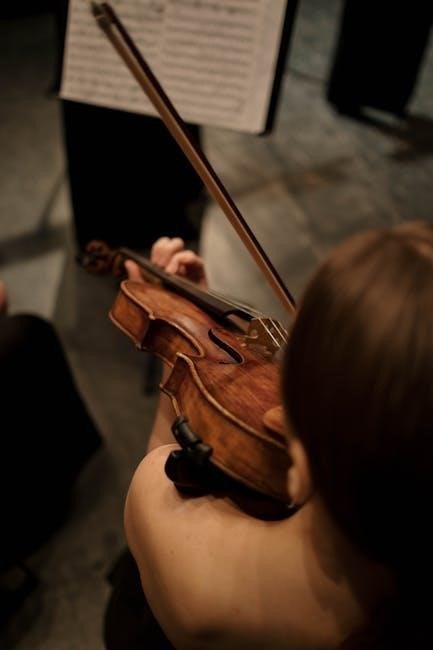
Arrangements
Pachelbel’s Canon in D has been arranged for various ensembles, maintaining its elegant charm․ Sheet music in PDF format is available for orchestral and chamber versions, offering versatility․ Musicians can explore these adaptations to suit different performance settings, ensuring the piece’s timeless appeal endures across diverse musical contexts․
Orchestral Versions
Orchestral arrangements of Pachelbel’s Canon in D offer a grand and dynamic interpretation, showcasing the piece’s harmonic richness․ These versions often feature a full ensemble, including strings, woodwinds, brass, and percussion, creating a lush and expansive sound․ The sheet music PDFs for orchestral versions provide detailed notation, allowing for precise execution of the intricate harmonies and counterpoint․ Musicians can explore the depth of the composition through layered dynamics and textures, making it a compelling choice for large-scale performances․ These arrangements highlight the versatility of the Canon, ensuring its timeless appeal in grand musical settings․
Orchestral versions are ideal for showcasing the piece’s full potential, blending tradition with modern instrumentation․
Chamber Music Versions
Pachelbel’s Canon in D is frequently performed in chamber music settings, particularly by string quartets or small ensembles․ These versions retain the original’s elegance while offering an intimate interpretation․ The sheet music, available in PDF format, often includes arrangements for Violin I, Violin II, Violin III, and bass, preserving the piece’s harmonic structure․ Chamber versions are popular in weddings and educational contexts, allowing for precise execution of the counterpoint; The reduced instrumentation highlights the interplay between parts, maintaining the work’s emotional depth․ These arrangements remain true to Pachelbel’s intent while adapting to smaller ensembles, ensuring clarity and focus․
Chamber music versions emphasize the Canon’s timeless beauty․
Performance Tips
Maintain a steady tempo and observe dynamic markings to enhance the piece’s emotional impact․ Ensure clear articulation and precise phrasing for optimal musical clarity and expression․
This approach highlights the Canon’s structural beauty․
Tempo and Dynamics
The ideal tempo for Pachelbel’s Canon in D is typically between 60 to 66 beats per minute, allowing a stately yet flowing performance․ Dynamics should be subtle, with a gradual increase in volume as the piece progresses․ Musicians are encouraged to begin softly, building to a moderate crescendo in the final sections․ Proper attention to these elements ensures the music’s serene and structured character is preserved․
Adhering to these guidelines enhances the overall musicality and audience appreciation of the piece․
Articulation and Phrasing
Pachelbel’s Canon in D requires precise articulation to maintain its elegant structure․ Violinists should emphasize legato playing, with smooth transitions between notes to preserve the piece’s flowing nature․ Slight variations in articulation can enhance the melody’s expressiveness while respecting the composition’s Baroque origins․ Phrasing should align with the harmonic progression, ensuring each section breathes naturally․ Attention to these details fosters a cohesive and engaging performance, highlighting the timeless beauty of the Canon․
Proper articulation and phrasing are key to conveying the music’s emotional depth and structural clarity․
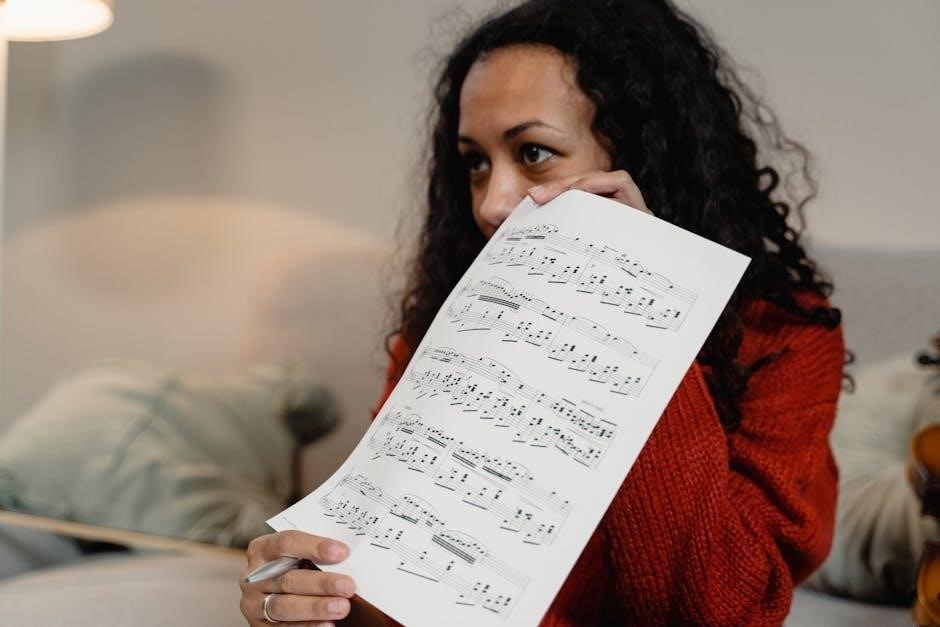
Cultural Impact
Pachelbel’s Canon in D is a cultural icon, symbolizing elegance and timelessness․ Its widespread use in weddings, media, and modern adaptations underscores its enduring influence and universal appeal․
It remains a cornerstone of classical music, bridging centuries and inspiring new generations of musicians and audiences alike․
Wedding Music
Pachelbel’s Canon in D is a quintessential choice for weddings, evoking elegance and romance․ Its gentle, flowing melody and harmonious structure create a serene atmosphere, making it a timeless favorite for ceremonies and receptions․ The piece’s universal appeal and emotional depth have cemented its place in wedding traditions worldwide․
Available as a free PDF, the sheet music is easily accessible, allowing couples and musicians to incorporate this beloved composition into their celebrations, further solidifying its role as a cultural symbol of love and unity․
Modern Adaptations
Pachelbel’s Canon in D has inspired countless modern adaptations, blending its timeless melody with contemporary styles․ From electronic remixes to pop covers, the piece’s versatility shines across genres․ Musicians and producers often use its harmonic structure as a foundation for new creations, showcasing its enduring appeal․
Additionally, the availability of sheet music in PDF and MIDI formats has made it accessible for modern artists to reinterpret the Canon, ensuring its relevance in today’s music landscape while preserving its classical essence․ This adaptability continues to introduce Pachelbel’s masterpiece to new audiences and generations․
Accessing the Sheet Music
Pachelbel’s Canon in D sheet music is widely available in PDF and MIDI formats․ Free downloads can be found on platforms like MuseScore and Musicnotes, ensuring easy access for musicians․
A PDF reader is required to view and print the files, making it convenient for performers to utilize the sheet music for practice and performance․
Free Resources
Free sheet music for Pachelbel’s Canon in D is readily available online․ Websites like MuseScore and Musicnotes offer downloadable PDF versions of the piece․ These resources are ideal for musicians seeking to practice or perform without cost․ While free versions may lack advanced features, they provide the essential musical notation needed․ Additionally, some platforms offer MIDI files for digital manipulation․ When accessing free resources, ensure the source is reputable to maintain musical accuracy and quality․ This accessibility has made Pachelbel’s Canon a staple in both educational and performance settings worldwide․
Paid Options
Paid sheet music options for Pachelbel’s Canon in D offer enhanced features and quality․ These versions are available through platforms like Sheet Music Plus and Musicnotes․ They provide high-resolution PDFs, accurate transcriptions, and often include multiple parts for different instruments․ Some editions cater to specific ensembles, such as orchestral or chamber groups․ Paid options are ideal for professional performances or detailed study․ They ensure clarity and precision, making them a valuable investment for serious musicians․ Additionally, purchasing sheet music supports composers and publishers, contributing to the preservation of classical works․
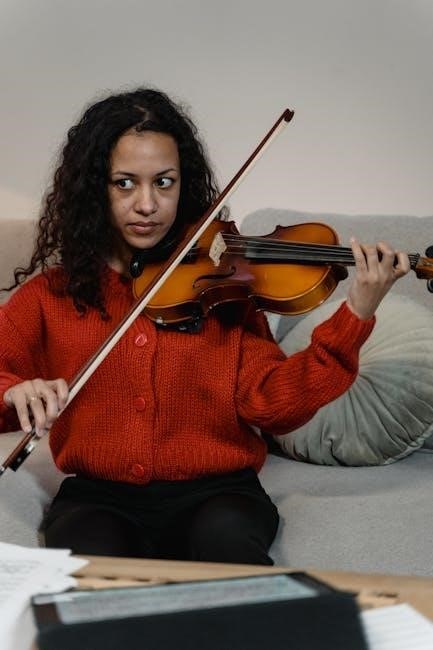
Working with the PDF
Utilize software tools to edit and print the PDF․ Ensure clarity and precision when adjusting notation․ Regularly save changes to maintain quality and integrity in the document․
Software Tools
Essential software tools facilitate efficient work with the PDF sheet music․ Adobe Acrobat is ideal for viewing and editing PDFs, ensuring clarity and precision․ For notation enthusiasts, Finale and Sibelius offer advanced editing capabilities․ MuseScore, a free alternative, allows customization and playback․ DAWs like Logic Pro or Ableton can import MIDI files for modern adaptations․ These tools cater to professionals and educators, enabling seamless navigation and enhancement of Pachelbel’s Canon in D, ensuring it remains accessible and manageable for all․
Editing Options
The PDF sheet music of Pachelbel’s Canon in D offers versatile editing options․ Musicians can adjust tempos, dynamics, and articulations using software like Finale or Sibelius․ MuseScore provides free tools for customization․ Additionally, MIDI files can be imported into DAWs for modern interpretations․ Editors can also add ornaments or modify instrumentation to suit ensemble needs․ These options allow performers to tailor the piece while preserving its timeless essence, ensuring it remains adaptable for various musical settings and preferences, all while honoring Pachelbel’s original composition․
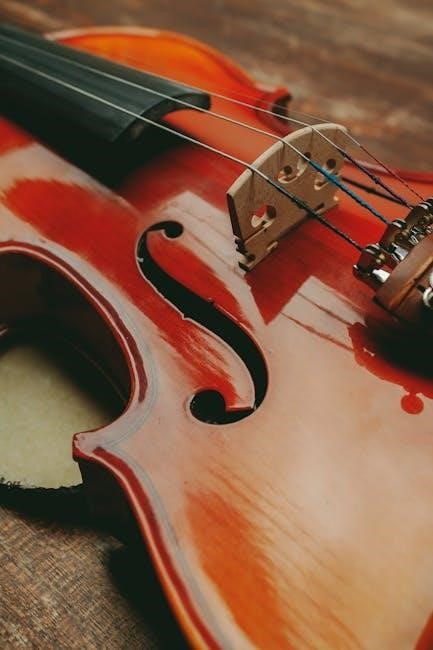
Educational Use
Pachelbel’s Canon in D is widely used in music education, with its sheet music in PDF format offering a structured way to teach harmony and composition․ It provides a foundational piece for students to analyze and perform, promoting understanding of Baroque music and ensemble playing․ The repetitive yet intricate structure makes it ideal for teaching musical concepts, benefiting both novice and advanced learners in various educational settings․
Teaching Strategies
Pachelbel’s Canon in D serves as an excellent educational tool, with its sheet music in PDF format offering practical teaching opportunities․ Educators can use the canon to instruct students on Baroque musical structure, harmonic progression, and ensemble performance techniques․ The repetitive bass line provides a clear framework for teaching counterpoint and variation․ Additionally, the piece can be broken down into sections for analysis, allowing students to explore individual violin parts and their roles within the larger composition․ Teachers can also incorporate the PDF sheet music into lesson plans, using it to demonstrate musical phrasing, dynamics, and articulation․ This approach fosters both theoretical understanding and practical performance skills, making it a valuable resource for music education programs․
Learning Resources
Learning Pachelbel’s Canon in D is made accessible through various resources․ The sheet music in PDF format is widely available, offering clear notation for violin parts․ Online tutorials and video guides provide step-by-step instruction, while MIDI files allow students to hear individual parts․ Additionally, educational websites offer interactive tools to practice tempo and dynamics․ Teachers can use the canon to explain Baroque counterpoint and harmonic structure․ Workshops and masterclasses further enhance understanding, making it a rich resource for both beginner and advanced learners․ These tools collectively support a comprehensive learning experience․
Pachelbel’s Canon in D remains a timeless masterpiece, cherished for its elegant structure and harmonic beauty․ Widely available as a PDF, the sheet music has democratized access, enabling musicians of all levels to engage with this Baroque gem․ Its enduring popularity in weddings, educational settings, and modern adaptations underscores its universal appeal․ As a teaching tool, it illuminates key musical concepts, while its soothing tones continue to inspire performers and audiences alike․ This piece stands as a testament to the power of music to transcend time, making it an indispensable part of classical repertoire and cultural heritage․

No Responses